Doncaster

The first "crest" worn by the team appeared in 1911-12 when the club's initials were embroidered onto the centre of the shirt in large lettering.
In August 1914 the club went into liquidation but a new company was formed almost immediately and took over the formers club's fixtures. When professional competition was suspended in 1915, the club closed down and the Intake Ground was taken over by the Army and used as a military depot. In the summer of 1920 Rovers were revived but were without a home ground as the Army were still using their former home. With the help of Doncaster Corporation, a new ground was built and named Belle Vue. Rovers application to the new Third Division (North) in 1921 was not successful but in 1923 the division was expanded and this time Doncaster's application was accepted.
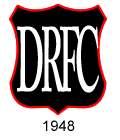 In 1935, now wearing hooped shirts, Rovers were promoted to the Second Division where they lasted two seasons before being relegated. Immediately after the Second World War, the club won the Third Division (North) championship twice (1947, 1950 - they were relegated in 1948) and became established in the middle of the Second Division.
In 1935, now wearing hooped shirts, Rovers were promoted to the Second Division where they lasted two seasons before being relegated. Immediately after the Second World War, the club won the Third Division (North) championship twice (1947, 1950 - they were relegated in 1948) and became established in the middle of the Second Division.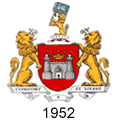
In the 1948-49 season, the team often wore white shirts at home during the autumn while their normal hooped tops were used at other times. The new shirts had "DRFC" embroidered onto a black shield edged in red. In 1950 Rovers adopted white shirts as their official first choice but with the lettering appearing out of a red shield edged in black. This was briefly replaced in 1952-53 with the Doncaster coat of arms.
Successive relegations in 1958 and 1959 took Rovers back down to the Fourth Division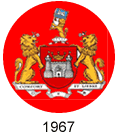 and in 1962 they had to apply for re-election. During the late 1960s Rovers twice won the Fourth Division title (1966 and 1969) but were relegated soon afterwards.
and in 1962 they had to apply for re-election. During the late 1960s Rovers twice won the Fourth Division title (1966 and 1969) but were relegated soon afterwards.
The town coat of arms reappeared in 1966 on a red rectangle and then, from 1967 to 1972, on a red disc.
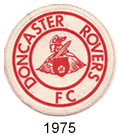 Throughout the 1970s Doncaster were firmly stuck in the lowest division. The familiar viking crest appeared for the first time in 1972 on programme covers and then on players' shirts in 1975. The commonly accepted story behind the new design is that the manager of the time, Maurice Setters, was casting about for a new design when an advertisement for Rover cars caught his eye. Although it has not been
Throughout the 1970s Doncaster were firmly stuck in the lowest division. The familiar viking crest appeared for the first time in 1972 on programme covers and then on players' shirts in 1975. The commonly accepted story behind the new design is that the manager of the time, Maurice Setters, was casting about for a new design when an advertisement for Rover cars caught his eye. Although it has not been 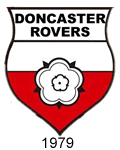 possible to verify this story it seems plausible as Doncaster is not known for having Viking connections (it was in fact a minor Roman garrison town).
possible to verify this story it seems plausible as Doncaster is not known for having Viking connections (it was in fact a minor Roman garrison town).
In 1979 a smart new crest (without the viking) was designed to go with Rovers' smart new white Sereena strips. This was replaced in 1982 when 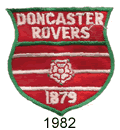 Hobott took over as the club's kit provider and added green as an accent colour.
Hobott took over as the club's kit provider and added green as an accent colour.
During the 1980s Rovers had two spells in the Third Division but in 1988 they were relegated back to Division Four. The viking crest was revived in 1987 and became 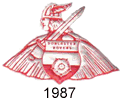 firmly established as the supporters' favourite, appearing on the various combinations of red and white worn over the following nine seasons.
firmly established as the supporters' favourite, appearing on the various combinations of red and white worn over the following nine seasons.
During discussions with the kit supplier, Patrick, before the 1996-97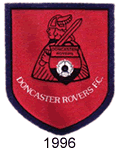 season, a club official was asked give details of the club crest. Instead of providing an original sample, he drew a rough sketch. The result was the rather poorly designed badge shown here on the left.
season, a club official was asked give details of the club crest. Instead of providing an original sample, he drew a rough sketch. The result was the rather poorly designed badge shown here on the left.
During Rover's disastrous 1997-98 campaign the crest only appeared for part of the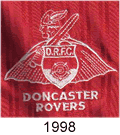 season at the end of which they finished bottom of the League and were relegated to the Conference, the third time they had lost League status. The familiar viking returned in October 1998 picked out in white and with the club's name underneath. This was replaced the following season by a full colour version.
season at the end of which they finished bottom of the League and were relegated to the Conference, the third time they had lost League status. The familiar viking returned in October 1998 picked out in white and with the club's name underneath. This was replaced the following season by a full colour version.
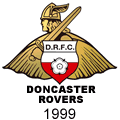 Between 1999 and 2001 the club produced kits under it's own "Viking Leisurewear" brand. The second of these introduced a brand new crest of obscure design. The only link with previous versions was the
Between 1999 and 2001 the club produced kits under it's own "Viking Leisurewear" brand. The second of these introduced a brand new crest of obscure design. The only link with previous versions was the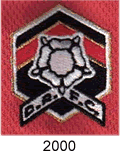 inclusion of the Yorkshire rose.
inclusion of the Yorkshire rose.
When Vandanel took over as kit supplier in 2001, they introduced hooped shirts recalling Rovers' pre-war heritage. Furthermore the popular viking crest was reinstated: this was identical to the 1999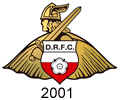 version but with the "Doncaster Rovers" lettering omitted.
version but with the "Doncaster Rovers" lettering omitted.
After five seasons in the Conference, Rovers became the first club to gain promotion to the League via the new play-offs, going on to win the Nationwide Division Three title at the first attempt. In May 2008 Doncaster reached the play-off final where they unexpectedly beat Leeds United to earn a place in The Championship, England's second tier.
I am grateful to Christopher Worrall, an authority on Doncaster's history, for his extensive input to this section.
